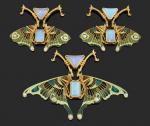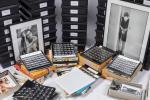La Gazette Drouot, Caroline Legrand

Attributed to Nicolas Sageot (1666-1731), commode of “La Naissance de Vénus“ (Birth of Venus), “Boulle“ marquetry in first part brass on tortoiseshell background, ormolu ornamentation, 91.5 x 130.5 x 70.5 cm/36.02 x 51.37 x 27.75 in.
Estimate: €50,000/70,000

René Lalique (1860-1945), set of three butterfly motifs, circa 1900, yellow gold, plique-à-jour polychrome enamel, round old-cut diamonds, cabochon-set opals, signed on each motif, h. 11.5 et 7 cm/4.52 x 2.75 in.
Estimate €60,000/80,000

Henri Martin (1860-1943), Les Bords de la Garonne, c. 1906, canvas, 38.5 x 65 cm/15.15 x 25.59 in.
Estimate: €30,000/40,000

Jean-François Jonvelle (1943-2002), photographic collection, including negatives, contact sheets, prints, model contracts, documentation and the photographer's handwritten diary.
Estimate: €50,000
For the 37th Garden Party, the Rouillac family (father and son) is relocating to the Château de Villandry. From a chest of drawers attributed to Sageot to Jean-François Jonvelle's photographic collection, not forgetting Italian Baroque sculpture, this eclectic program will pique everyone's curiosity.
The Château de Villandry, a landmark Renaissance estate in the Loire Valley, provides the perfect backdrop for this event, especially as its owner Henri Carvallo is well acquainted with auctioneers Aymeric and Philippe Rouillac, who have often advised him on purchases to decorate the property. The 441 lots to be sold over the two days should delight this passionate family of collectors, who are particularly fond of antique furniture. While metal marquetry in brass and tortoiseshell was pioneered by André-Charles Boulle, it was also masterfully employed by Nicolas Sageot, who was awarded the title of Master in 1706 and set up as a free-lance worker in the Grande-Rue du Faubourg-Saint-Antoine, to whom a commode (chest of drawers) known as “The Birth of Venus” is attributed. Estimated at €50,000/70,000, until today this commode has remained with the descendants of Ernest Pariset (1826-1912), one of Lyon's most prominent silk manufacturers and historians of his time, and son of André-Aimé Pariset, Governor of French Guyana and a key player in the abolition of slavery. Usually, we present furniture in its original condition, but this time, this chest of drawers were recently restored," explains Aymeric Rouillac. However, it was made according to the rules of the art at Château de Frétay by specialist Marie-Hélène Poisson, well known in the Vendôme region. The profusion of brass decoration on a tortoiseshell background is remarkable, also the result of the work of marker Toussaint Devoy (died 1753), a benchmark in his field at the time, who also supplied panels to Jean-Alexandre Oppenordt. The extremely rare top depicts the Birth of Venus. This iconography can be found on another piece of furniture stamped by Nicolas Sageot, formerly in the collections of the Earl of Lincoln, Clumber Park (sold at Christie's on December 16, 1999, under no. 50). The commedia dell'arte-themed side decorations echo those of another commode in the Wallace Collection, London (F408). These grotesque motifs plunge us into the heart of the court of Louis XIV and the work of the ornamentalist Jean Berain (1640-1711).
From Lalique to Jonvelle
The end of the 19th century saw the full expression of nature in works of art, starting with René Lalique's Art Nouveau jewelry creations. For example, a set of three butterfly motifs, an ephemeral and poetic animal, with wings in plique-à-jour polychrome enamel—a medieval technique that the goldsmith and jeweler revisited to create boldly modern pieces—could seduce at €60,000/80,000. Impressionist painters, for their part, gave free rein to their emotions in front of the landscape, such as Gustave Loiseau in Glaçons sur l'Oise (1914), a painting that passed through the Durand Ruel Gallery and came from the estate of Dr. Armand Maurin, in Paris. Having settled in Pontoise in 1904, the painter focused his work on the cycle of the seasons, using views of the Hermitage neighborhood and its bridge, as in this composition. Expect to pay €25,000/30,000 for this variation on the winter theme, similar to Bords de la Garonne by Henri Martin, a painting acquired at the Palais Galliera sale on December 8, 1973 (€30,000/40,000). Presented at the 1906 Salon des Artistes Français, this work is one of the preparatory studies for the famous set of thirteen canvases produced between 1903 and 1906 by the painter from the Southwest of France for the Salle des Pas Perdus in Toulouse's Capitole building. More precisely, this is a sketch for the composition of an evening stroll along the river. The poets, writers and politicians do not appear here, as the painter concentrates on this superb panorama, flooded with intense light that overpowers the architecture and creates reflections in the water. Between poetry and provocation, the final word will go to Jean-François Jonvelle, whose entire photographic collection will be offered for sale, along with the rights to it. The hammer price will be €50,000 for the collection, which includes hundreds of thousands of negatives in 44 boxes spanning his entire career, tens of thousands of contact sheets in Ilford and Kodak boxes, dozens of plates of his best shots and exhibition prints. From the 1960s until his sudden death in 2022, Jonvelle was considered the “photographer-poet of fashion”. Working for leading magazines, he captured the portraits of the greatest actresses of his time, from Nathalie Baye to Cécile de France and Agnès Jaoui, often in velvety black and white, with delicacy and sensuality. Covering Yves Saint Laurent's autumn-winter season in 1966-1967, he also photographed the 1981 advertising campaign for the poster company Avenir, which revolutionized the sector with its use of teasing and its slogans “Le 2 septembre j'enlève le haut” (“September 2, I take off the top“), then “Le 4 septembre, j'enlève le bas” (September 4, I take off the bottom). Model Myriam Szabo posed nude in the final poster of this scandalous campaign.




